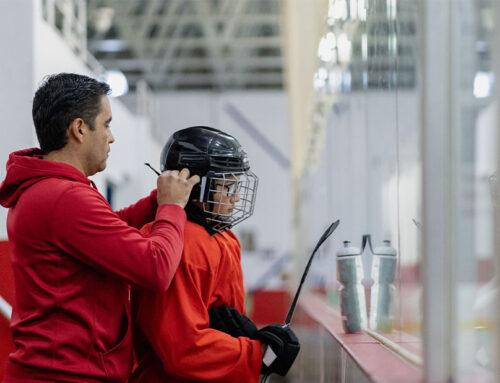High school track and field events
The great thing about high school Track & Field is that there is an event for everyone. There are races that are run on a 400-meter track and several different jumping and throwing events. With this combination of running, jumping, and throwing events, an athlete is bound to find an event which they enjoy and have the ability to excel. Most high schools have a spring outdoor season and there are a few that also have a winter indoor season which has a different variety of events. Below you will see a list of outdoor high school track events.
In Track & Field, girls and boys compete separately; however, they often practice together. At the high school level, an athlete is allowed to compete in four events each meet. Some states have eliminated the javelin and pole vault, and some states modify race distances but there is always a variety of events to choose from. And it is a good idea for young athletes to try different events when they first join a track team, and over time they will learn which events they are better at and that they enjoy participating in.
Running Events
100-Meter
This is an all-out sprint and is the shortest race during the outdoor season. It is run on the 100-meter straightaway of the track, and from the time the gun goes off at the start to the finish line, the athlete is running as fast as they possibly can. The athlete starts the race with their body lowered down in starting blocks, where they brace their feet so they don’t slip when the starting gun goes off, and they stride forward to begin the race. The 100-meter is a relatively short race, so perfecting the start is essential.
200-Meter
The 200 Meter is a power sprint and places more emphasis on speed endurance than the 100-Meter. The athlete starts in blocks and runs the first 100 meters on the curve of the track and then ends on the straightaway. 400 Meter
This is an endurance sprint event. On a standard outdoor track, the 400-meter is one lap around. Athletes start staggered on the curve and run in separate lanes for the entire race, ending on the straightaway. Most athletes start in blocks; however, some high school 400-meter runners do not. The 400-meter is often referred to as a “long sprint”.
800-Meter
The 800 meters is the shortest middle-distance running event. It is two laps around a standard outdoor track. Athletes make standing starts from a staggered position and stay in lanes until the end of the first bend. This event requires excellent natural endurance and great speed for a strong finish.
Mile
This is the longest middle-distance race and requires more aerobic endurance than the 800-meter. It is the only race that has not switched to meters.
100-Meter Hurdles (Girls)
In this race, the athlete sprints 100 meters as fast as they can while hurdling ten barriers placed on the straightaway.
110-Meter Hurdles (Boys)
In this race, the athlete sprints 110 meters as fast as they can while hurdling ten barriers placed on the straightaway.
300-Meter Hurdles
This event requires the speed of a sprinter, the strength of an 800-meter athlete, and the skills of a 100/110-meter hurdler. The race starts on a stager, and the athlete stays in their lane for the entire 300 meters. They hurdle eight barriers over 300 meters and finish on the straightaway. (Professional, College, and USATF events run the 400 Meter Hurdles.)
4 x 200-Meter Relay (Girls)
A relay is a track event that involves four athletes working together, each running a leg of the race. Each athlete runs a specific distance and then passes a baton to the next athlete on the relay team until all four have run and the final runner passes the finish line. The 4 x 200-meter relay is only run at the high school level and is run by girls.
4 x 100-Meter Relay
In the 4 x 100 relay, each athlete runs 100 meters. The entire race equals 400 meters or one lap on a standard outdoor track. The baton handoff is extremely important in this relay as the athletes are traveling at top speed and have a small zone to make the handoff. A race can be lost if the passing of the baton is sloppy or the baton is dropped.
4 x 400-Meter Relay
The 4 x 400-meter relay is the final race of the track meet. It is an exciting race to watch as each team’s best sprint endurance athletes work to finish four laps in record time. The handoffs are not as crucial during this relay; however, they are still important as there is a specific zone where the baton can be passed as each athlete runs their 400 meters.
Field Events
Shot put
This field event involves “putting” (or pushing) a heavy metal ball as far as possible. Boys use a 12-pound shot and girls an 8.8-pound shot. The athlete starts in a seven-foot diameter circle, and then holding the shot near their shoulder, they put it as far as they can from the edge of the circle and into a designated area.
Discus
In this field event, the athletes throw a heavy disc as far as possible. The discus is thrown from a circle that is 8.2 feet in diameter into a sector that is marked beyond the circle.
Javelin
The javelin is a field event where a spear that is 8 feet in length, is thrown as far as possible. The thrower runs down a straight runway to gain momentum and then plants their foot behind a specified line and then throws the javelin into a dedicated area.
High Jump
In this field event, athletes must jump over a horizontal bar that is placed between two standards. There is a large mat on the other side of the bar to land on. The athlete is trying to jump higher than the other competitors. They get three attempts to jump a specified height without knocking the bar off the stand. As the athlete clears a height, the bar is raised, and then each athlete that cleared the previous height is given three more chances to jump the next height. Athletes can choose to skip heights; however, the last cleared height will count as their highest jump.
Long Jump
This is an event in which the athlete combines speed, strength, and agility to jump as far as possible. They run down a straight runway and leap from behind a line on the runway (usually a board) as far as they can into a sandpit. If the athlete crosses the line with their toe, it is considered a foul, and the score does not count. They get three attempts, and the longest jump counts as their final score. The top scores often go into a final round of jumping.
Triple Jump
This is another event in which the athlete combines speed, strength, and agility to jump as far as possible. In the Triple Jump (sometimes referred to as the hop, skip and jump), the athlete runs down the runway and performs a hop, a bound, and then a jump into the sandpit. The hop must be on the same foot, and then during the bound the athlete switches to the other foot for the jump. (Left, left, right or right, right, left)
Pole vault
In this event, athletes use a long flexible pole, made of either fiberglass or carbon fiber, to leap over a bar that is held by stands. The athlete runs down a straight runway and then transfers their forward momentum upward, using the pole to vault over the bar. As in the high jump, athletes get three opportunities to clear the bar at each height.
Multi Events (Decathlon and Heptathlon)
Most high schools do not have Multis; however, there are Multi Events where high school students can participate. Multis are competitions where athletes participate in several events over two days of competition. The events are scored to get a final tally, and the athlete with the top score wins the competition.
Decathlon (Boys)
The Decathlon consists of eight events. 100 Meters, Long Jump, Shot Put, High Jump, 400 Meters, 110 Meter Hurdles, Discus Throw, Pole Vault, Javelin, 1500 Meters
Heptathlon (Girls)
The heptathlon consists of 110-meter hurdles, high jump, shot put, 200 meters, long jump, javelin, 800 meter
RECOMMENDED FOR YOU
MOST POPULAR
High school track and field events
The great thing about high school Track & Field is that there is an event for everyone. There are races that are run on a 400-meter track and several different jumping and throwing events. With this combination of running, jumping, and throwing events, an athlete is bound to find an event which they enjoy and have the ability to excel. Most high schools have a spring outdoor season and there are a few that also have a winter indoor season which has a different variety of events. Below you will see a list of outdoor high school track events.
In Track & Field, girls and boys compete separately; however, they often practice together. At the high school level, an athlete is allowed to compete in four events each meet. Some states have eliminated the javelin and pole vault, and some states modify race distances but there is always a variety of events to choose from. And it is a good idea for young athletes to try different events when they first join a track team, and over time they will learn which events they are better at and that they enjoy participating in.
Running Events
100-Meter
This is an all-out sprint and is the shortest race during the outdoor season. It is run on the 100-meter straightaway of the track, and from the time the gun goes off at the start to the finish line, the athlete is running as fast as they possibly can. The athlete starts the race with their body lowered down in starting blocks, where they brace their feet so they don’t slip when the starting gun goes off, and they stride forward to begin the race. The 100-meter is a relatively short race, so perfecting the start is essential.
200-Meter
The 200 Meter is a power sprint and places more emphasis on speed endurance than the 100-Meter. The athlete starts in blocks and runs the first 100 meters on the curve of the track and then ends on the straightaway. 400 Meter
This is an endurance sprint event. On a standard outdoor track, the 400-meter is one lap around. Athletes start staggered on the curve and run in separate lanes for the entire race, ending on the straightaway. Most athletes start in blocks; however, some high school 400-meter runners do not. The 400-meter is often referred to as a “long sprint”.
800-Meter
The 800 meters is the shortest middle-distance running event. It is two laps around a standard outdoor track. Athletes make standing starts from a staggered position and stay in lanes until the end of the first bend. This event requires excellent natural endurance and great speed for a strong finish.
Mile
This is the longest middle-distance race and requires more aerobic endurance than the 800-meter. It is the only race that has not switched to meters.
100-Meter Hurdles (Girls)
In this race, the athlete sprints 100 meters as fast as they can while hurdling ten barriers placed on the straightaway.
110-Meter Hurdles (Boys)
In this race, the athlete sprints 110 meters as fast as they can while hurdling ten barriers placed on the straightaway.
300-Meter Hurdles
This event requires the speed of a sprinter, the strength of an 800-meter athlete, and the skills of a 100/110-meter hurdler. The race starts on a stager, and the athlete stays in their lane for the entire 300 meters. They hurdle eight barriers over 300 meters and finish on the straightaway. (Professional, College, and USATF events run the 400 Meter Hurdles.)
4 x 200-Meter Relay (Girls)
A relay is a track event that involves four athletes working together, each running a leg of the race. Each athlete runs a specific distance and then passes a baton to the next athlete on the relay team until all four have run and the final runner passes the finish line. The 4 x 200-meter relay is only run at the high school level and is run by girls.
4 x 100-Meter Relay
In the 4 x 100 relay, each athlete runs 100 meters. The entire race equals 400 meters or one lap on a standard outdoor track. The baton handoff is extremely important in this relay as the athletes are traveling at top speed and have a small zone to make the handoff. A race can be lost if the passing of the baton is sloppy or the baton is dropped.
4 x 400-Meter Relay
The 4 x 400-meter relay is the final race of the track meet. It is an exciting race to watch as each team’s best sprint endurance athletes work to finish four laps in record time. The handoffs are not as crucial during this relay; however, they are still important as there is a specific zone where the baton can be passed as each athlete runs their 400 meters.
Field Events
Shot put
This field event involves “putting” (or pushing) a heavy metal ball as far as possible. Boys use a 12-pound shot and girls an 8.8-pound shot. The athlete starts in a seven-foot diameter circle, and then holding the shot near their shoulder, they put it as far as they can from the edge of the circle and into a designated area.
Discus
In this field event, the athletes throw a heavy disc as far as possible. The discus is thrown from a circle that is 8.2 feet in diameter into a sector that is marked beyond the circle.
Javelin
The javelin is a field event where a spear that is 8 feet in length, is thrown as far as possible. The thrower runs down a straight runway to gain momentum and then plants their foot behind a specified line and then throws the javelin into a dedicated area.
High Jump
In this field event, athletes must jump over a horizontal bar that is placed between two standards. There is a large mat on the other side of the bar to land on. The athlete is trying to jump higher than the other competitors. They get three attempts to jump a specified height without knocking the bar off the stand. As the athlete clears a height, the bar is raised, and then each athlete that cleared the previous height is given three more chances to jump the next height. Athletes can choose to skip heights; however, the last cleared height will count as their highest jump.
Long Jump
This is an event in which the athlete combines speed, strength, and agility to jump as far as possible. They run down a straight runway and leap from behind a line on the runway (usually a board) as far as they can into a sandpit. If the athlete crosses the line with their toe, it is considered a foul, and the score does not count. They get three attempts, and the longest jump counts as their final score. The top scores often go into a final round of jumping.
Triple Jump
This is another event in which the athlete combines speed, strength, and agility to jump as far as possible. In the Triple Jump (sometimes referred to as the hop, skip and jump), the athlete runs down the runway and performs a hop, a bound, and then a jump into the sandpit. The hop must be on the same foot, and then during the bound the athlete switches to the other foot for the jump. (Left, left, right or right, right, left)
Pole vault
In this event, athletes use a long flexible pole, made of either fiberglass or carbon fiber, to leap over a bar that is held by stands. The athlete runs down a straight runway and then transfers their forward momentum upward, using the pole to vault over the bar. As in the high jump, athletes get three opportunities to clear the bar at each height.
Multi Events (Decathlon and Heptathlon)
Most high schools do not have Multis; however, there are Multi Events where high school students can participate. Multis are competitions where athletes participate in several events over two days of competition. The events are scored to get a final tally, and the athlete with the top score wins the competition.
Decathlon (Boys)
The Decathlon consists of eight events. 100 Meters, Long Jump, Shot Put, High Jump, 400 Meters, 110 Meter Hurdles, Discus Throw, Pole Vault, Javelin, 1500 Meters
Heptathlon (Girls)
The heptathlon consists of 110-meter hurdles, high jump, shot put, 200 meters, long jump, javelin, 800 meter










